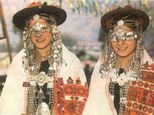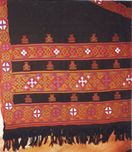The Kullu Shawls
|The Kinnauri Shawls | The Extra
Weft Woven Shawls

 Widely
renowned for the intricacy and finesse in weaving Kinnauri Shawls
are unique. Their elaborate geometrical designs bear a strong
Central Asian influence. Many of the motifs woven have a very
special symbolic and religious significance. The colours used
for ground are white, black, natural grey and brown. The main
colours used for patterning are red, orange, pink, blue, green,
yellow, black and white. Out of these five colours represent five
elements—white stands for water, yellow for earth, red for fire,
green for air and blue for aether.
Widely
renowned for the intricacy and finesse in weaving Kinnauri Shawls
are unique. Their elaborate geometrical designs bear a strong
Central Asian influence. Many of the motifs woven have a very
special symbolic and religious significance. The colours used
for ground are white, black, natural grey and brown. The main
colours used for patterning are red, orange, pink, blue, green,
yellow, black and white. Out of these five colours represent five
elements—white stands for water, yellow for earth, red for fire,
green for air and blue for aether.
Many a times, they have patterned borders running all along the
four edges thereby increasing the labour involved and making them
more expensive than Kullu Shawls. Most of the shawls for commercial
use are woven on the frame loom, though the ones for local use
are still woven on the pitloom. Here the weaver weaves it in two
pieces of half width each and later joins them from the center
with elaborate hand stitching. This serves the dual purpose of
function and ornamentation.
Technical Specifications

Yarn Used
- Warp - 2/48's woollen worsted.
- Weft - 2/48's woollen worsted, hand-spun—Indian wool, Pashmina,
Angora (Rabbit wool).
- Patterning - 2/32's woollen worsted/ acrylic (Cashmelon).
Size - 2 m X 1 m.
Weave - 2/2 twill (base) & weft rib in patterning.
Weight - If woven in 2/48's count the weight of one woman's
shawl may vary from 360 to 390 gm depending on the pattern and
design. However if yarn of other counts or handspun yarn is used,
no definite weight can be predicted. It will depend on count of
yarn and pattern/ design.

